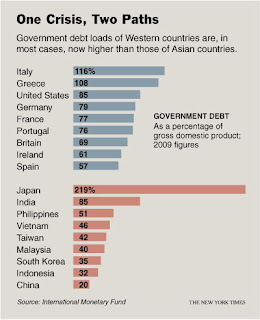Fast forward to 2010 and the roles are clearly reversed. The US and European economies are suffering from fiscal woes, and the recesison is driving them deeper into debt. The skeletons tumbling from the sub-prime cupboard has demolished all illusions of a superior form of "western capitalism" and battered the reputations of politicians and bankers alike.
The crisis has not spared acedemics either. A minor civil war has broken out amongst them. The same economists and institutions who called for squeezing expenditures, reining in government debts, hiking interest rates and striving for macroeconomic balancing during the East Asian crisis are now calling for exactly the opposite measures under much the same economic conditions.
The emerging economies have evidently learnt their lesson. They have worked hard to get their public debt and deficits under control, financial markets more transparent and better regulated, and build up comfortable amount of foreign exchange reserves. Some would say they have done too good a job of the challenges they faced, especially with respect to building up government surpluses and forex reserves.
Times has this excellent graphic which nicely sums up the reversal of roles with government debts.

Even in the case of the high debt Japan and India, the share of external debt is minimal and the risk of a sovereign default is minimal. I have blogged earlier about India's higher debt default threshold here.
Nouriel Roubini makes the clinching comment that "sovereign risk today is a greater problem in advanced economies than in most emerging market economies". He also feels that the trend of many developed economies resorting to monetization of their fiscal deficits (central banks swelling the monetary base via massive purchases of short- and long-term government paper) is a recipe for unleashing inflationary expectations, and rise in long-term government bond yields.
Update 1 (21/3/2010)
IMF's Deputy MD, John Lipsky offered a grim prognosis for the world’s wealthiest nations, which are at a level of indebtedness not seen since the aftermath of World War II. The average ratio of debt to gross domestic product in advanced economies was expected this year to reach the level that prevailed in 1950. Even assuming that fiscal stimulus programs are withdrawn in the next few years, that ratio is projected to rise to 110 percent by the end of 2014, from 75 percent at the end of 2007. The ratio is expected to be close to or to exceed 100 percent for five of the Group of 7 countries — excluding Canada and Germany — by 2014.
Maintaining public debt at postcrisis levels could reduce potential growth in advanced economies by as much as half a percentage point annually, compared with projections before the crisis. To reduce debt ratios to the pre-crisis average of 60 percent by 2030 would require an 8 percentage point swing — from a structural deficit of about 4 percent of G.D.P. in 2010 to a surplus of about 4 percent of G.D.P. in 2020. IMF estimates that advanced economies would have to take steps, like changes in pensions and health care programs, other cutbacks in spending and higher tax revenues to rein in their debt ratios, apart from a global rebalancing of savings patterns.
No comments:
Post a Comment